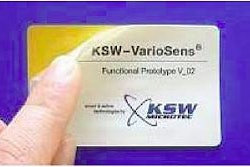
Matt Ream is senior manager of RFID Systems for Zebra Technologies, a manufacturer of on-demand bar-code, smart label, and RFID printers and printers/encoders.
PW: What’s your one best piece of advice for packagers set to implement RFID in 2006?
Ream: Do not wait until you receive a mandate letter from a large customer to start learning and implementing. A lot of companies that waited until the 11th hour in the first round of compliance from Wal-Mart, for example, were left scrambling to figure things out on their own. All of the qualified RFID integrators were booked up and couldn’t avail their time. Many of these companies also ran into lead time problems procuring RFID tags, readers, and so forth.
PW: What is the most significant benefit that RFID affords today?
Ream: Among packaged goods companies, it’s greater visibility within the supply chain using less labor. RFID provides more automated scanning capability. It enables users to read a greater number of items in a short period of time, with no increase in labor overhead. Users can analyze the tracking data gleaned via an RFID system, feed that information into different business metrics, and then make solid efficiency improvements to their overall processes.
PW: From a scalability perspective, does slap-and-ship, now often referred to as tag-and-ship, make sense anymore?
Ream: We see more value in implementing a full RFID system. But for some companies that have a few stock keeping units, slap-and-ship gets them going.
Unfortunately, though, many of the companies that implemented a minimal slap-and-ship solution in the first round of RFID mandate compliance later realized that they hadn’t figured out the ROI model. They also didn’t internally integrate the technology into other systems. The smart ones invested in systems that could actually tie into their ERP or WMS systems, and also supported a greater range of reader infrastructure when they were ready to do that as well.
But no matter what kind of system you implement, definitely make sure that you’re investing in equipment that’s scalable. That goes for hardware as well as software. The last thing you want to do is roll out a system that’s going to be obsolete in six to 12 months, or one that can’t grow when you’re ready to grow.
PW: Now that Gen 2 products are out, with more on the way, what’s next in terms of RFID technology advances?
Ream: I think what we’ll see in the coming years is much more cost-effective and feature-rich RFID product differentiation. Additional memory on RFID tags is one example, and Gen 2 supports this. A 96-bit memory currently serves as the EPC license plate. But if you look at applications like food and beverage, or pharmaceutical, there exists significant value in having additional memory on the RFID tag, where you can embed lot and date codes, or manufacturing information. Such data is highly valuable in the supply chain to track and trace product, and is good for recalls should the latter be necessary.
One of the other advances that we’ll see from a technology perspective is more plug-and-play capability. We’ll start to see this type of innovation in 2006 from printer and reader manufacturers. As we progress into 2007 and 2008, I think we’ll see many new players entering the chip arena that we hadn’t seen before. The RFID Pavilion at Pack Expo International this fall will be a great resource for packagers to review these types of innovations.
PW: In light of Gen 2 and ISO 18000-6 protocols, how do you see RFID playing out globally, especially in terms of interoperability?
Ream: I think the issue of global interoperability has been solved with the implementation of the Gen 2 standard. You now have a technology platform that spans the globe across different frequency ranges.
One of the things to keep in mind, however, is that there are some “acceptable” differences in frequency ranges and power levels. This means that the same RFID product will perform a bit differently in Chicago than it will in London. What we’ll hopefully see in the 2007-2008 time frame is that areas like the EU will adopt a regulatory environment that’s closer to that which exists in the U.S., which would, in turn, give them better performance. Right now, it’s not as good.
In 2006, I think that China will sort out what it wants to do from a frequency and power perspective. China’s the big hold-out right now, but we think things are progressing well there.
PW: Will RFID replace the bar code?
Ream: We think RFID and bar codes will walk hand-in-hand for quite some time. There’s always going to be the need for human-readable identification, as is the case with barcodes today: the number printed beneath them serves as a failsafe in case the barcode isn’t readable. The same thing applies to RFID.
A case in point is the DoD’s labeling specification, which makes it mandatory to have all RFID data backed up into a PDF 417 bar code as a redundant means of identification. What that provides is interoperability throughout the entire supply chain, even though you may not have an RFID read point at every location.
PW: When RFID holds so much promise why are so many organizations reluctant to adopt it?
Ream: I think much of the reluctance is due to the fact that humans inherently don’t like change. But it’s a perception issue as well. Seemingly, to a lot of folks, RFID is a new and unproven technology, and far more expensive at the outset compared to bar code or other technologies. These perceptions are unfortunate, as there is very good ROI in many applications. Getting to solid ROI involves putting together a solid business plan, and looking at process re-engineering. One of the things I always tell customers is that they’re never fundamentally going to reap all the benefits of RFID without business process change. That’s one of the biggest pain points in the whole process.
PW: RFID is a technology that has been in existence for more than 50 years. Looking ahead, how do you see RFID evolving over the next 50 years?
Ream: It’s virtually impossible to say where any technology will be in 50 years, but looking ahead, RFID will get more powerful and easier to use, and less expensive. Insofar as advances in the technology, there’s great promise in some of the polymer-based chip technologies that companies are taking a look at for printed circuits and so forth. I think these technologies are a long way from being commercially viable, but they’re definitely interesting to watch evolve.
Editor’s note: When Pack Expo International opens October 29 in Chicago, it will be the 50th anniversary of this important show. To mark Pack Expo’s continued value and admirable longevity, we’re running a series of Q&A spotlights on key packaging technologies. The first installment in the series comes courtesy of Zebra Technologies Corp.(www.zebra.com).























